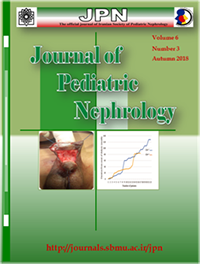Percutaneous Nephrolithotomy in Pediatric age Group: Our Experience
Journal of Pediatric Nephrology,
Vol. 6 No. 3 (2018),
19 February 2019
,
Page 1-4
https://doi.org/10.22037/jpn.v6i3.23462
Abstract
Introduction: Pediatric urolithiasis is an uncommon disease with incidence varying widely throughout the world. We present our experience in pediatric PCNL in 20 pediatric patients with urolithiasis.
Materials and Methods: Case records of all patients under 14 years of age who presented with urolithiasis from 2016 March to February 2017 were retrospectively reviewed and analyzed with respect to demographic details, clinical presentation, stone characteristics, PCNL puncture site, number, stone clearance, ancillary procedures used, complications, and follow-up status of the children. Associated biochemical abnormalities were also reviewed.
Results: There were 25 renal units in 20 patients (5 had bilateral stones). The mean age at presentation was 8.4 years. There were 15 males and 5 females. The most common presenting symptom was flank pain (n=19/20).
There were solitary stones in 17 renal units: 2 stones in 6 renal units and multiple stones in 2 renal units. The average stone size was 1.5cm. Four patients had staghorn calculi. Five patients required two punctures of whom 3 had bilateral disease and 2 had staghorn calculi. The sheath used ranged from 18 Fr to 22 Fr. The nephrostomy tube and DJ stent were kept in all patients.
The duration of the procedure at a single site ranged from 45 minutes to 75 minutes. Complete clearance was achieved in 19 patients while one patient required bilateral URS. Three patients had mild fever post-operatively. None of the patients required blood transfusion. Hypocalcaemia was detected in 7 patients.
Conclusions: PCNL is safe and effective for treating urolithiasis in children.
Keywords: PCNL; Urolithiasis; Pediatric.
- PCNL
- Urolithiasis
- Paediatric.
How to Cite
References
Veeratterapillay R, Shaw MBK, Williams R, Haslam P, Lall A, Hunt M De la, et al. Safety and efficacy of percutaneous nephrolithotomy for the treatment of paediatric urolithiasis. Ann R CollSurgEngl 2012;94: 588–592.
doi 10.1308/003588412X13373405387014
Gearhart JP, Herzberg GZ, Jeffs RD. Childhood urolithiasis: experiences and advances. Pediatrics 1991;87:445–450.
Basaklar AC, Kale N. Experience with childhood urolithiasis. Report of 196 cases. Br J Urol 1991;67:203–205.
Milliner DS, Murphy ME. Urolithiasis in pediatric patients. Mayo Clin Proc 1993;68:241–248.
Woodside JR, Stevens GF, Stark GL et al. Percutaneous stone removal in children. J Urol 1985;134:1166–1167.
Bilen CY, Koçak B, Kitirci G et al. Percutaneous nephrolithotomy in children: lessons learned in 5 years at a single institution. J Urol 2007;177:1867–1871.
Bogris S, Papatsoris AG. Status quo of percutaneous nephrolithotomy in children. Urol Res 2010;38:1–5.
Boormans JL, Scheepe JR, Verkoelen CF, Verhagen CMS. Percutaneous nephrolithotomy for treating renal calculi in children. BJU Int2005;95:631-4. doi:10.1111/j.1464-410X.2005.05351.
Cohen TD, Ehreth J, King LR, Preminger GM. Pediatric urolithiasis. medical and surgical management. Urology 1996;47:292–303.
Stapleton FB. Clinical approach to children with urolithiasis. SemNephrol 1996;16:389–97.
Noe HN, Stapleton FB, Jerkins GR, Roy S. Clinical experience with pediatric urolithiasis. J Urol 1983; 129:1166–8.
Bennet AH, Colodny AH. Urinary tract calculi in children. J Urol 1973;109:318– 20.
Mahmud M, Zaidi Z. Percutaneous nephrolithotomy in children before school age: experience of a Pakistani centre. BJU Int 2004;94,1352–1354 doi:10.1111/j.1464- 410X.2004.05173.
Fernstrom I, Johannson B. Percutaneous pyelithotomy: a new extraction technique. Scand J UrolNephrol 1976;10:257–60.
Partalis N, Sakellaris G. Paediatric urolithiasis. Essentials in Ped Urol 2012;79-88 ISBN:978-81-308-0511-5.
Ganpule AP, Mishra S, Desai MR. Percutaneous nephrolithotomy for pediatric urolithiasis. Indian J Urol2010;26:549-54.
Straub M, Gschwend J, Zorn C, Pediatric urolithiasis: the current surgical management. PediatrNephrol2010;25:1239-1244.
Wickham JEA, Miller RA, Kellet JE et al. Percutaneous nephrolithotomy: one stage or two. Br J Urol 1984;56:582–5.
Samad L, Aquil S, Zaidi Z. Paediatric percutaneous nephrolithotomy: setting new frontiers. BJU Int 2006;97:359–363.
Aron M, Yadav R, Goel R et al. Percutaneous nephrolithotomy for complete staghorn calculi in preschool children. J Endourol 2005;19:968–972..
Badawy H, Salama A, Eissa M, Kotb E, Hashem M, Shoukri I. Percutaneous management of renal calculi: Experience with percutaneous nephrolithotomy in children. J Urol 1999;162:1710–3.
Jackman SV, Hedican SP, Docimo SG, Peters CA. Infant and preschool age percutaneous nephrolithotomy: Experience with a new technique. Urology 1998;52:697–701.
Unsal A, Resorlu B, Kara C et al. Safety and efficacy of percutaneous nephrolithotomy in infants, preschool age, and older children with different sizes of instruments. Urology 2010;76:247–252.
Guven S, Istanbulluoglu O, Gul U et al. Successful percutaneous nephrolithotomy in children: multicenter study on current status of its use, efficacy and complications using Clavien classification. J Urol 2011;185:1419–1424.
Traxer O, Smith TG, Pearle MS et al. Renal parenchymal injury after standard and mini percutaneous nephrostolithotomy. J Urol 2001;165: 1693–1695.
Mor Y, Elmasry YE, Kellett MJ, Duffy PG. The role of percutaneous nephrolithotomy in the management of pediatric renal calculi. J Urol 1997;158(3 Pt 2): 1319–1321.
- Abstract Viewed: 296 times
- PDF Downloaded: 179 times

